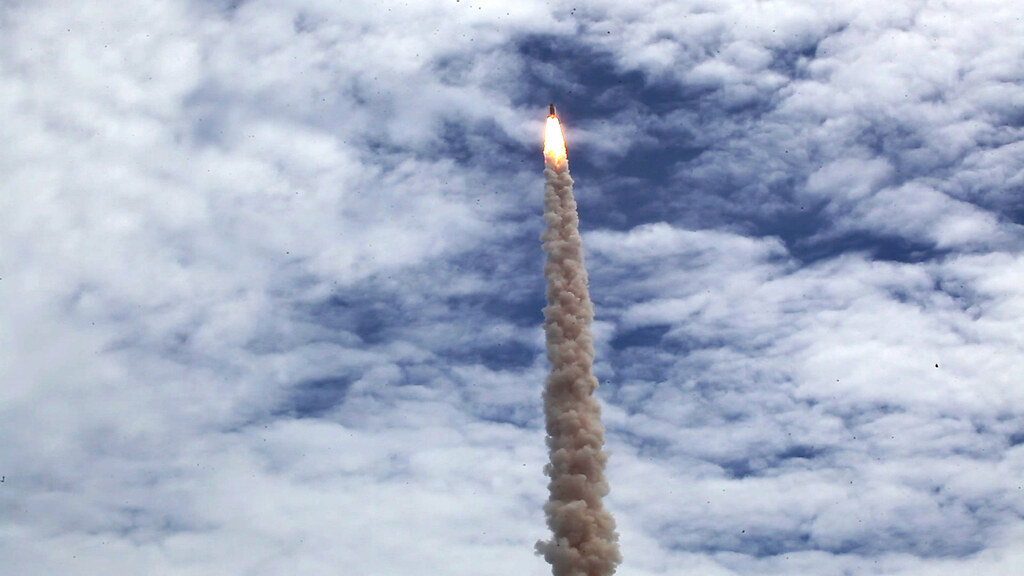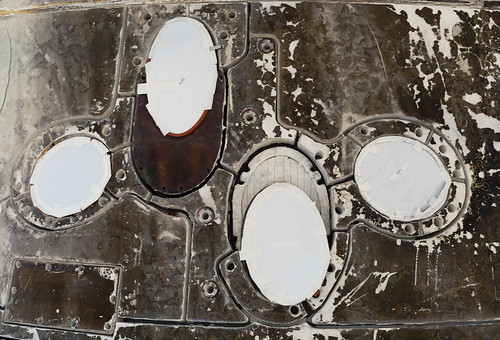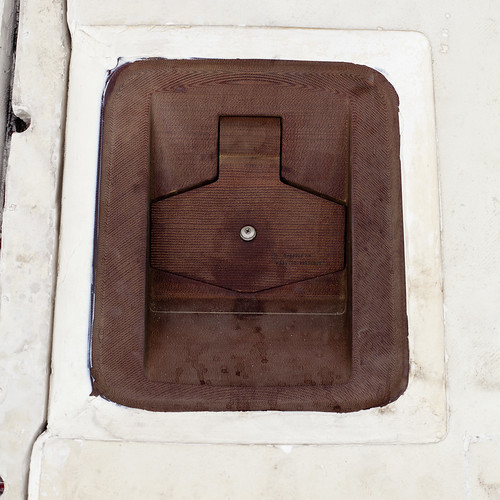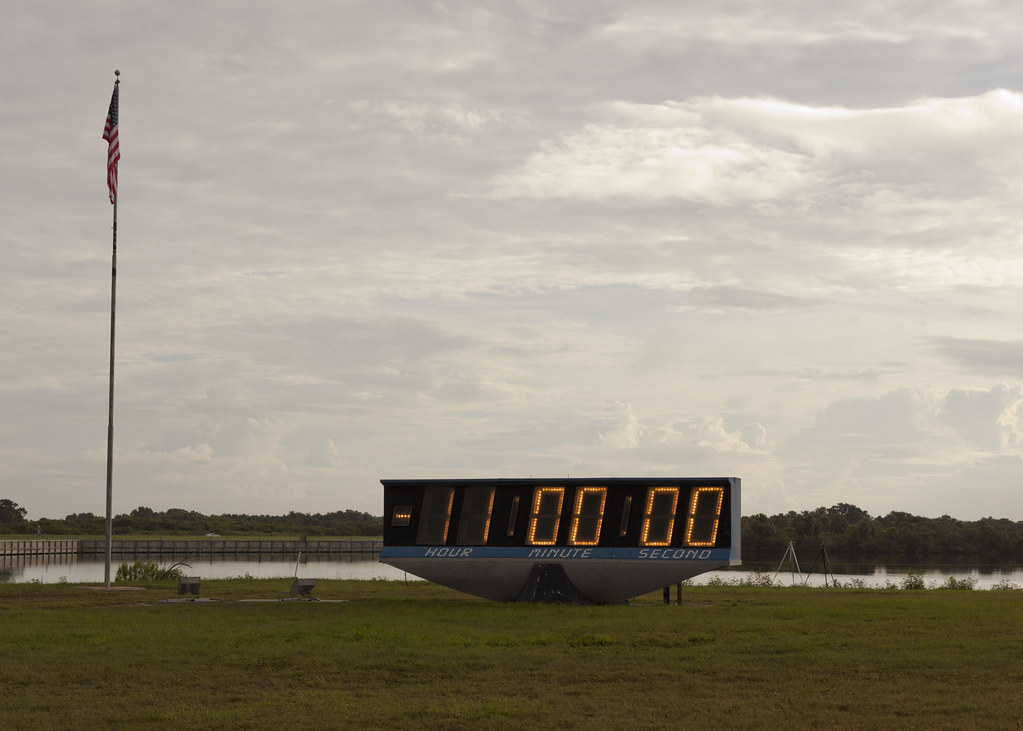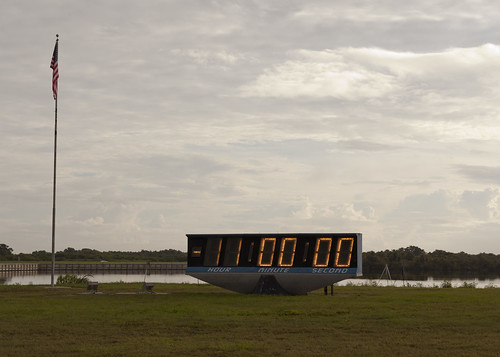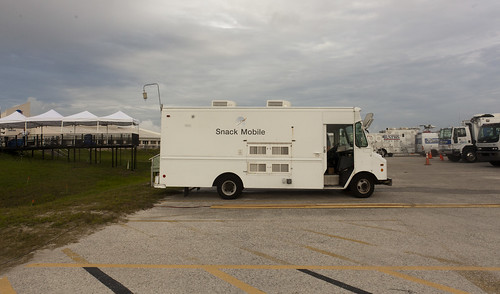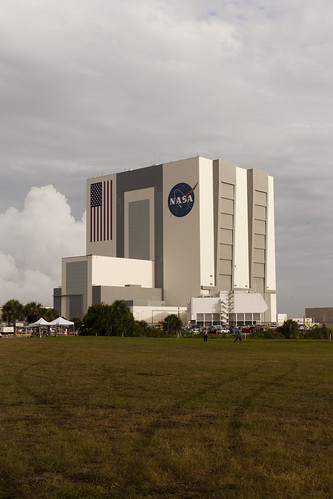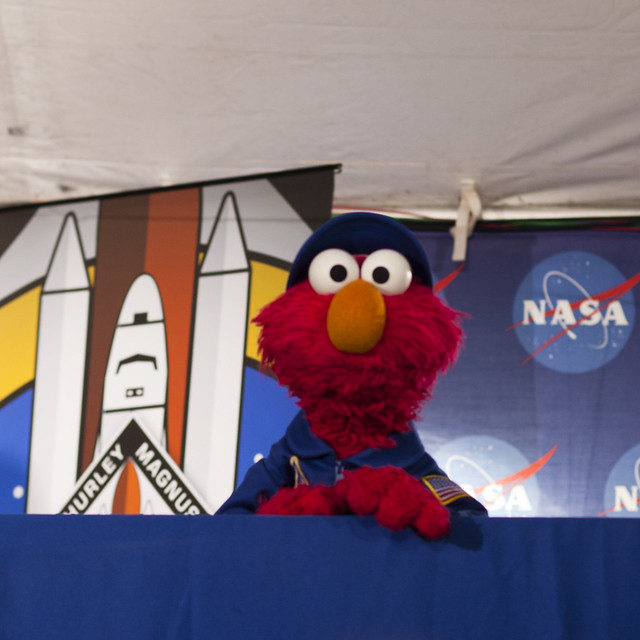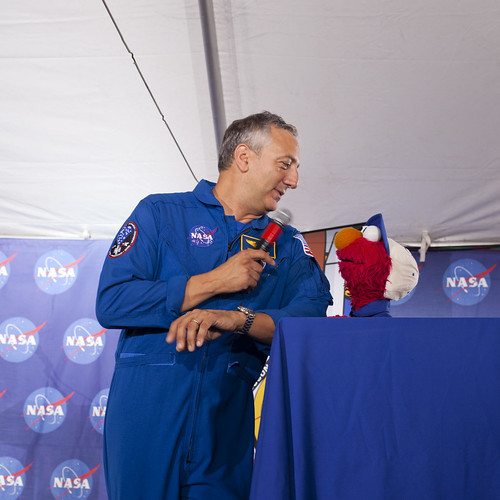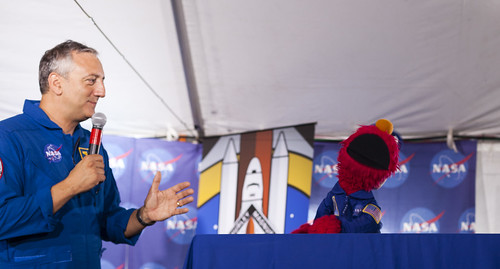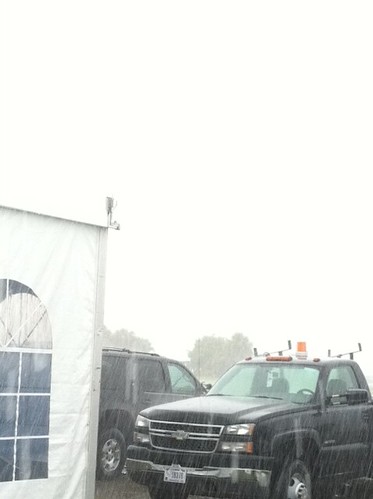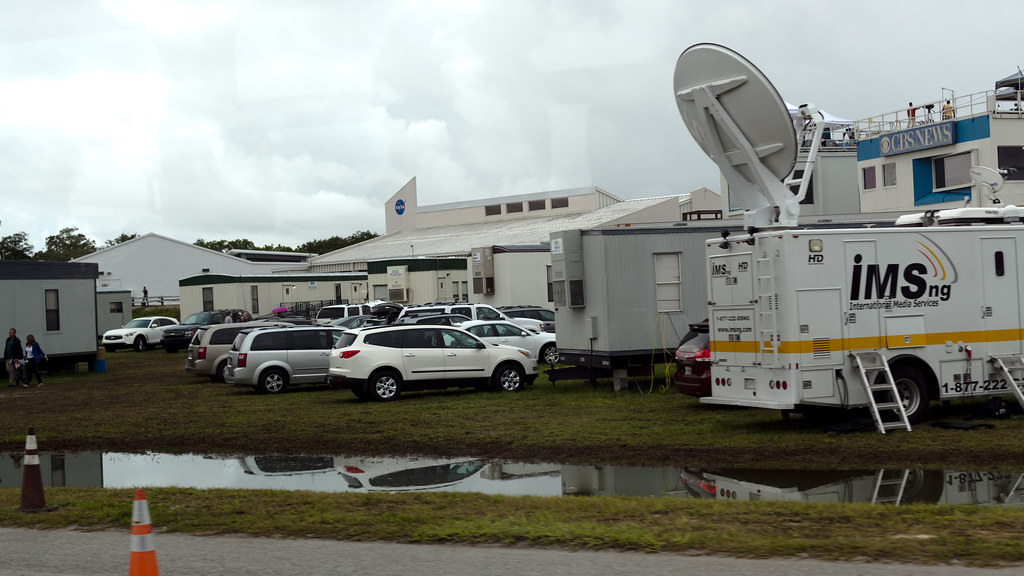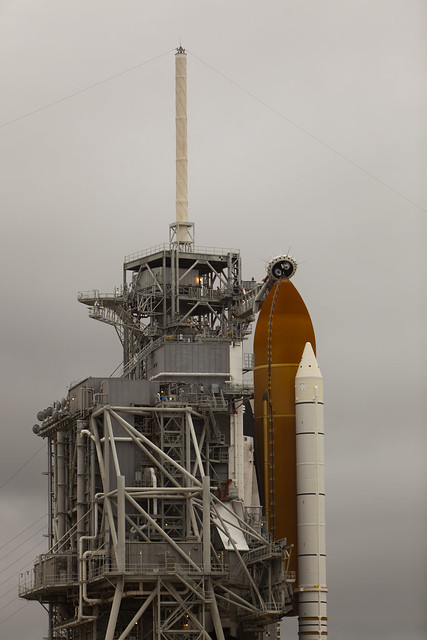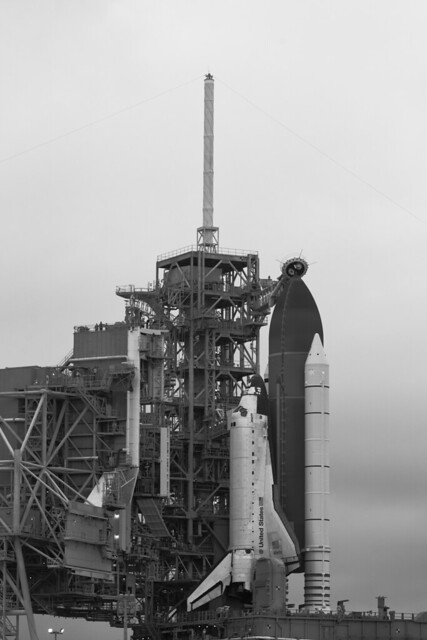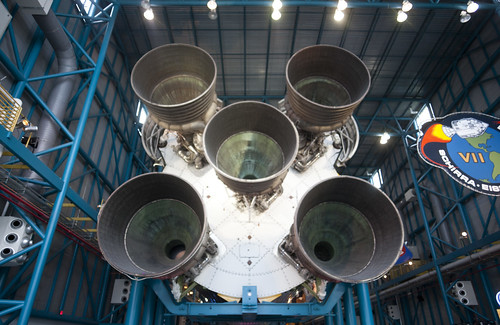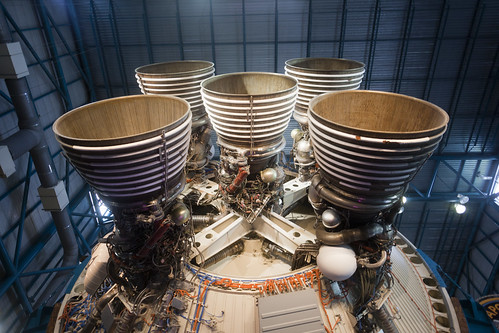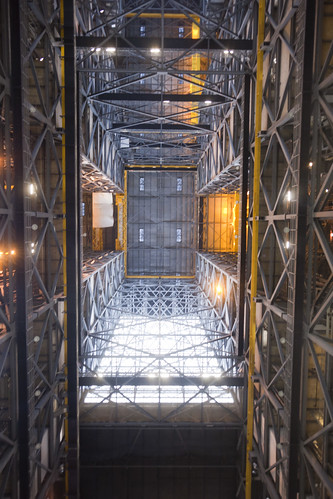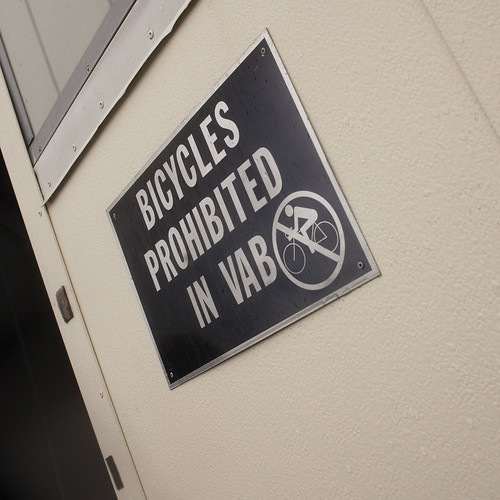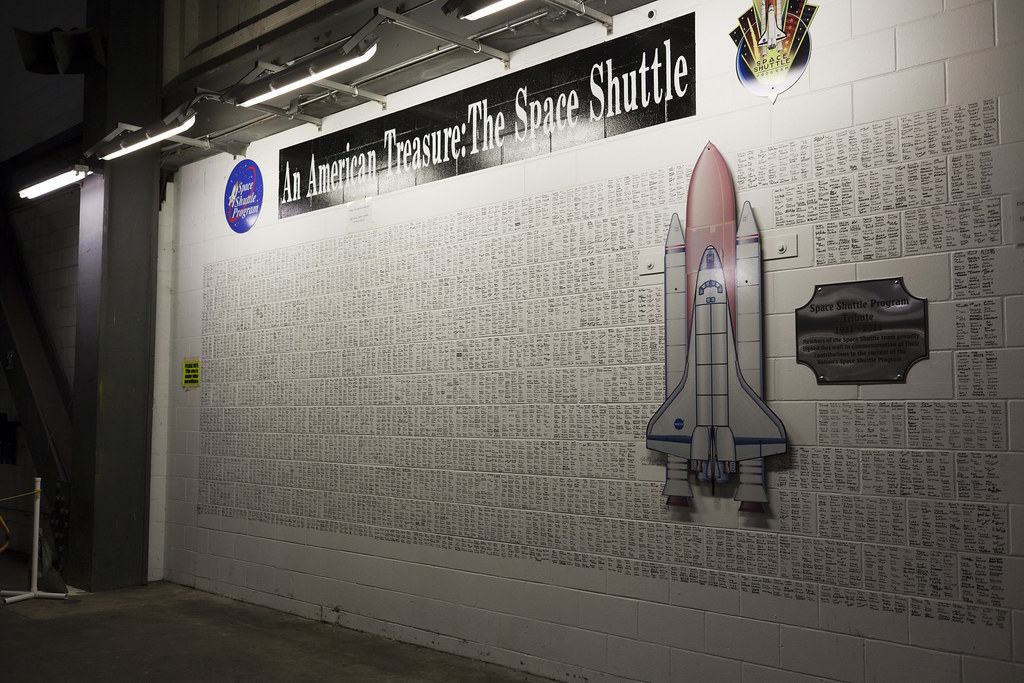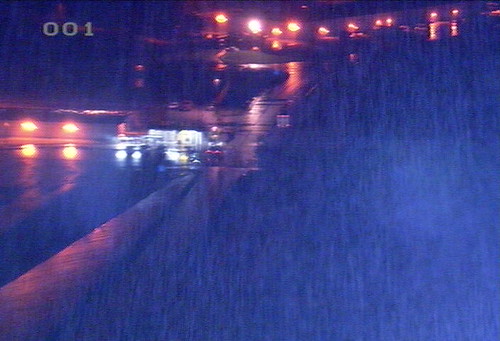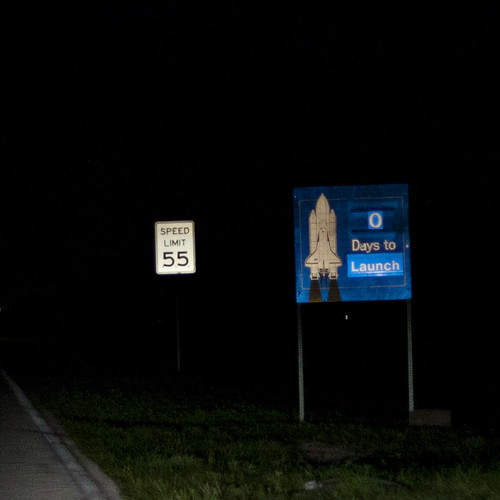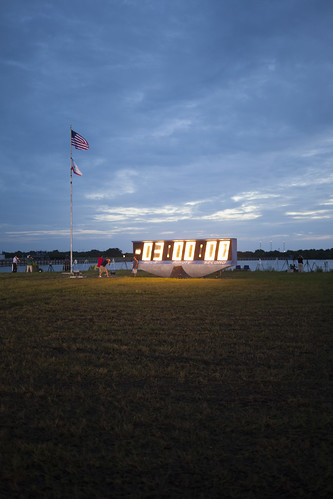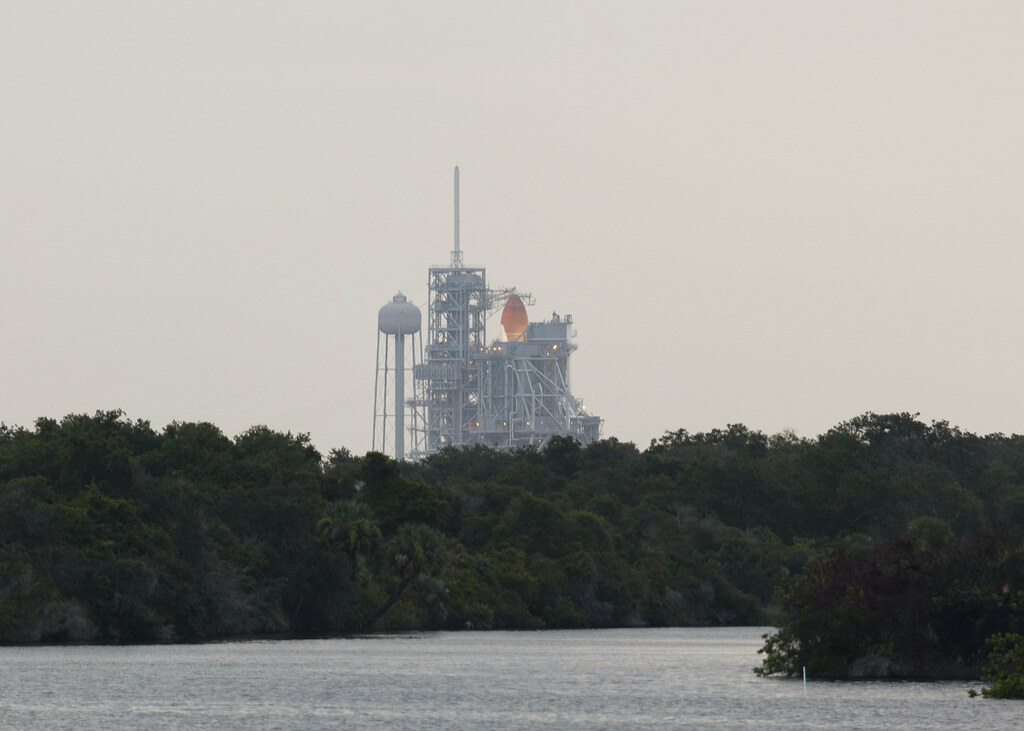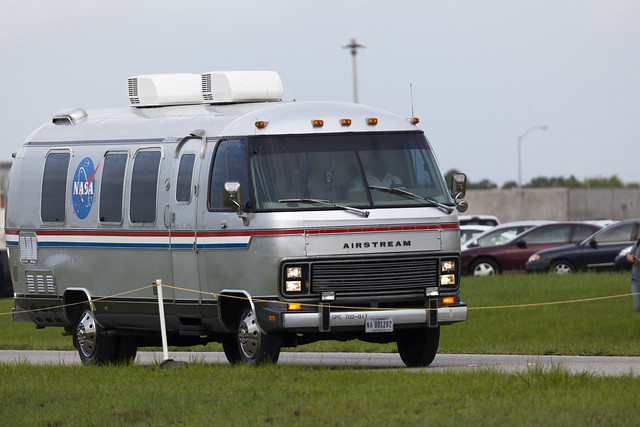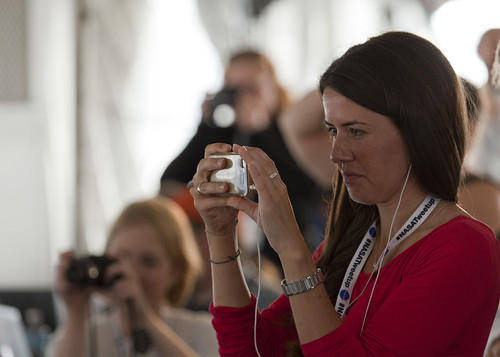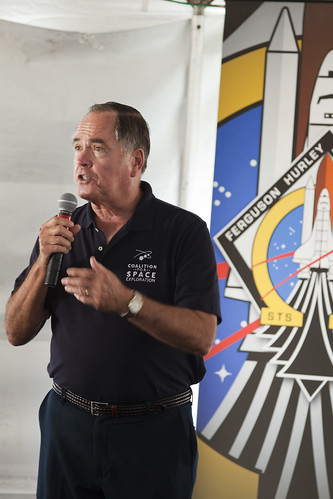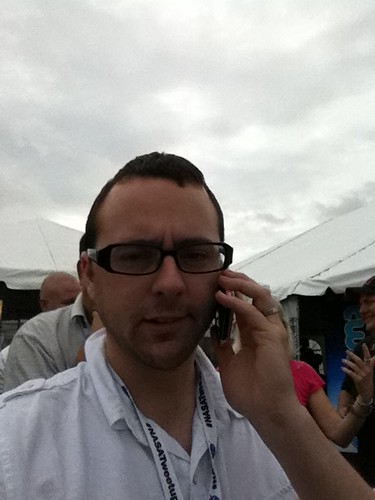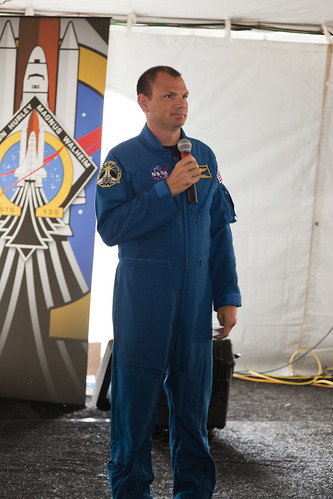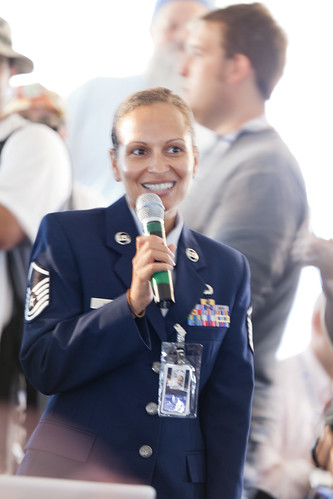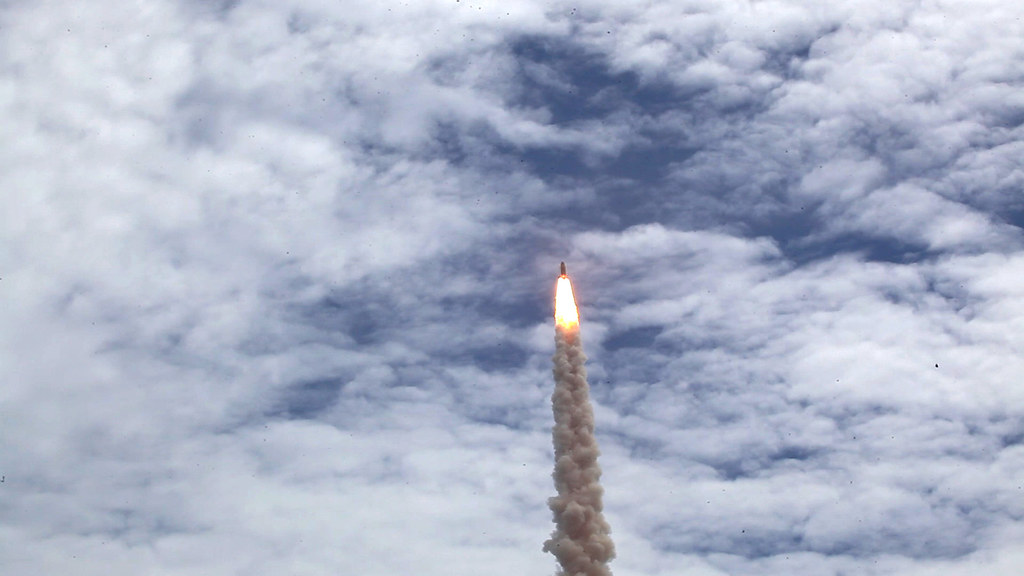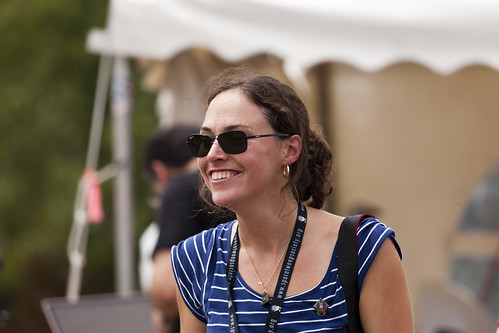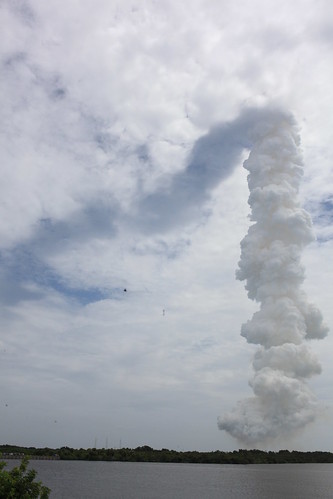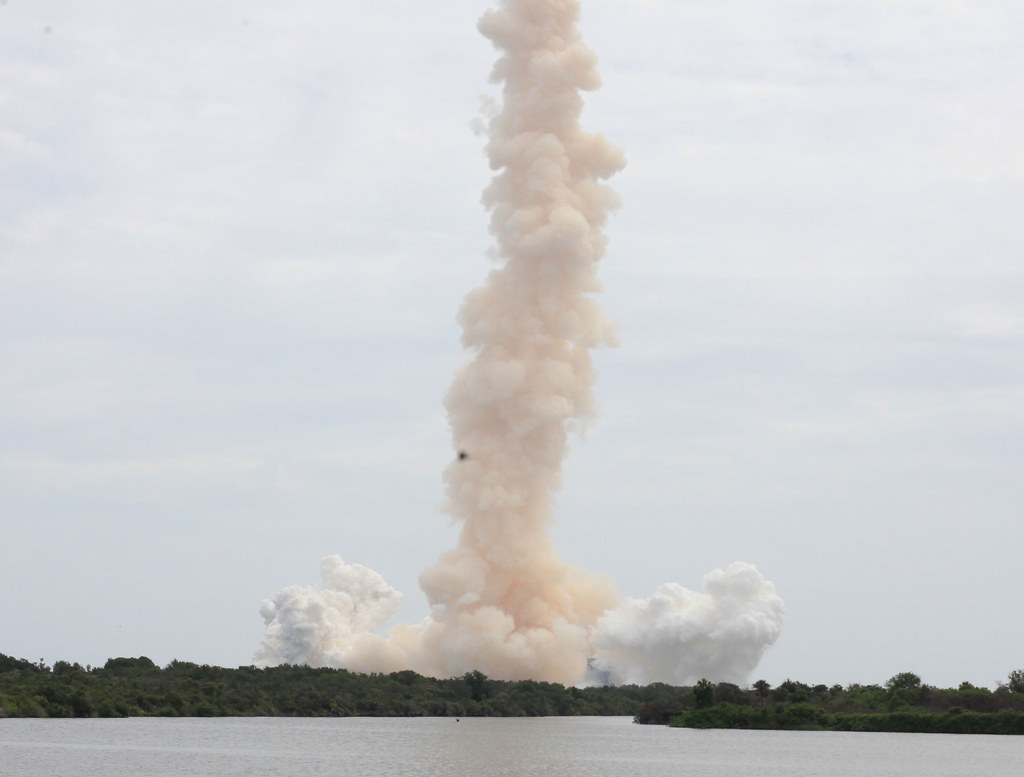NASAtweetup: Celebrating an End of an Era, but not end of Human Spaceflight
I use the term with the team: ‘Stay hungry. Stay Curious.’ You keep that hunger where you are inquisitive.
– Bill Gerstenmaier, NASA Associate Administrator for Space Operations
The Shuttle Transport System is as old as I am, gestated in the late 1970’s and coming of age in the 1980’s; I have always lived with the Shuttle Program. In less than two weeks, the Space Shuttle program will end. On Friday July 8th, 2011 the last Space Shuttle launched from Kennedy Space Center in Cape Canaveral, Florida. During her life, billions of dollars were spent, new techniques and technology were developed and lives were tragically lost.
Throughout the Shuttle’s short life the program inspired people throughout the world. This inspiration is not merely based on the technology – which is certainly very awesome; rather inspiration flows from the people who built, maintained and flew the Space Shuttle, who are an amazing group of people – both driven, and modest; rational yet creative; proud yet humble; forward-thinking yet aware of their great lineage. The Astronauts are but a single visible portion of the many thousands of women and men who make human space flight possible.
NASA is many things, both good and bad, yet the agency is certainly not done with human space flight. We might be near the end of the Space Shuttle Program, and until those four astronauts safety land, there is still work to be done.
American human space flight is not over, it merely is changing how we get to Low Earth Orbit (LEO). For awhile we will be paying the Russians for space aboard the Soyuz rockets to reach the International Space Station, but we will continue to have a permanent and continuous outpost in space. The ISS continues to be a centerpiece of our national science program – being the only National Laboratory not on US soil – for the next 15-20 years. NASA is working on the succession program to bring supplies and crew to LEO, and a new program to leave the gravity well of our home planet to touch the soil of distant asteroids, moons, and planets.
This is not a story of how we got here and where we are going, that is for another day. This is a story about honoring and taking part in the last Space Shuttle launch, as I was a lucky member of the STS-135 NASAtweetup, one of over 150, located at the press center at Kennedy Space Center.
Day 0, L-2
We were invited by SpaceX to see the Dragon Capsule which was sent up into LEO and safely returned. NASA is supporting Commercial Off The Shelf (COTS) programs which will focus on creating automated supply ships to Station, and at some point, Commercial Crew flights to Station.
Driving through the Space Coast to the house we rented, I was struck by how many people were there with shuttle memorabilia mounted to their cars.
Day 1, L-1
We found the Tweetup Tent, filled with excitement and a wifi key which was 26-digits long: the government is serious about network security.
We also introduced ourselves, and it seemed that no one felt their introduction was significant. Yet inside the tent were scientists, architects, students, politicians, models, Twitter and NASA employees. Some travelled from as close as the Space Coast, many from San Francisco, and some from overseas: one attendee was from Melbourne, Australia and travelled over 32 hours to attend the Tweetup.

Tracy Thumm (@ISS_Research) and Justin Kuglerm (@ISS_NatLab) talked to us about ongoing science missions to Station, detail of which amazed me due to their ingenious ways of cramming a lot of science within a very small cubic volume. It reminded me of the XKCD comic:
I could not tell if we were more excited to see Elmo or Astronaut Mike Massimino (Astro_Mike) & Doug Wheelock (Astro_Wheels; probably a little of both. I was impressed with Elmo who kept asking the astronauts to explain big words to him. Astro Mike, Astro Mike! What does exp-plor-ration mean?
It was all very cute – especially the part where Doug & Mike answered Elmo’s questions about diapers. And when Elmo admonished the crowed to be quiet and sit down before we went live.
Check out all my Elmo photos here.
http://www.ustream.tv/flash/viewer.swf
And the the sky opened up; the Heavens roiled and thundered
Florida is basically one big swamp; KSC is basically a sandbar; we were in a tent with metal poles – and a thunderstorm rolled in. Later on we found out that lighting with over 70,000 amps hit the launch pad, but at the time we were dry in the tent looking out at the torrential downpour. It was so loud that we could barely hear Doug Wheelock over the rain. Wheels went step by step on what happens during the last few minutes of the launch countdown, demystifying the jargon and acronyms.
If you watched a launch countdown, you might hear, “Atlantis OTC, close and lock your visors, and initiate O2 flow.” OTC is the Orbiter Test Conductor which manages pre-flight checkout and testing of Atlantis, and the team in the firing room. You might also hear NTD, which is NASA Test Director, which is in charge of the overall pre-launch testing, crew, Shuttle and staff at launch. Which is funny, since the acronym NTD is made out of an acronym. A recursive acronym.
Mr. Gerstenmaier, NASA Associate Administrator for Space Operations, visited us next. Mr. Gerstenmaier stressed how in awe he was to work with the remarkable civil and contract team remarking, “If you can construct a challenge for them, there is no question what this shuttle team can do to do the impossible, then make it look easy.”
Discussing the next NASA vehicle, Mr. Gerstenmaier stated that we aren’t going to see wings, since you don’t need wings to go to another planet, in fact you don’t want to carry wings to go to the Moon, Mars or a near-Earth object such as an asteroid. But for LEO he commented that, “I wouldn’t be surprised if a LEO vehicle have wings.” He had very nice words about the Tweetup, even mentioning the homemade, “No U-Turns” signs which the STS-134 Tweetup members held up for the previous launch.
And then it happened: a lightning event was called and we could not leave the tent. This included both Wheels and Mr. Gerstenmaier, who both certainly had more important things to do. Both were class acts, milling around the tent, signing autographs and talking to the attendees.
Rotating Service Structure Retract
The rotating service structure provides protected access to the orbiter for installation and servicing of payloads at the pad, as well as servicing access to certain systems on the orbiter. We were able to watch the 15 minute rotation from about 1,500 feet (just under five football fields). During launch, if you were standing at this position you might not be incinerated by the engines, but you would certainly be killed by the overpressure wave created by the engines.
When the Space Shuttle Main Engines fire at T-6 a few things are happening: one, the onboard computers are verifying that each SSME is operating at 104% for a sustained time. And two, there is something called the Shuttle Twang: the off-center thrust pushes the entire stack forward (in the direction of the External Tank), then settles back into a somewhat vertical position. This is when the Solid Rocket Boosters fire at T-0 and the eight bolts holding the Shuttle to the launch pad are exploded, releasing the shuttle.
Above watch in almost realtime (it is about 1.5:1) the External Tank rocking north and then back south prior to ascent.
Vehicle Assembly Building
As we entered the Vehicle Assembly Building, which was inherited from the Apollo Program, the scale of the 526 foot tall building was enormous. Yet in its current empty state, the vastness of the 129,428,000 cubic feet space was hard to perceive. Currently NASA Administrators are looking at reusing the VAB for both the Heavy Lift Vehicle and for future Commercial vehicles.
Our guide had some really interesting facts about the VAB, some of which I had never heard before.
As NASA was sketching out the parameters of a reusable orbiter, project managers decided to reuse the Vertical Assembly Building from the Apollo mission. This decision constrained the width of the Space Shuttle in order to fit within the existing width of what is now called the Shuttle Transfer Bay.
The whole Apollo Program engineering team was housed in offices inside the VAB. All the way up and down the building there were offices: our guide’s office was high above the Low Bay. When the Shuttle Program took over the building, all of the offices had to vacate: with the addition of the Solid Rocket Booster into the launch stack, the VAB turned into an ordinance handling facility. The Saturn V used liquid propellent, so when the rocket stack was assembled, there was no propellent on board.
The 2 am Decision: Begin Tanking the ET, if possible, or Scrub
Night came quickly, the drive back down to Indiatlantic not so much, with a stop at Memaw’s Bar-B-Q for what turned out to be fairly dry barbeque.
We knew that there would be a 1:30 am meeting by Shuttle Test Directors to review all technical systems, the weather, and to decide to begin fueling the External Tank (ET) with its load of liquid oxygen and hydrogen. This four hour process was required in order to press to the T-3hr hold, and the launch. If any major system was out of order, or if the weather prohibited tanking (lighting, fuel and oxidizers don’t mix well) then the launch would have to occur the next day.
We thought about drawing straws for who would stay up until 2 am to see if Tanking occurred, but the mission management team indicated that they would press on with the tanking no matter what the weather forecast; if they did not tank, there would be a zero percent chance of launch; no matter that the weather forecast at the time was a 30% chance of favorable launch conditions. We drifted to bed concerned about the weather, but excited about a new day.
I awoke at 4:00 am with a sense that today would be a dress rehearsal; the weather was certainly not going to clear in time for the 11:29 am launch and we would be going through the motions. But we, and it was now a we, would scrub. Everyone in the house felt the same way: excited for a possible launch, resigned to returning to the house hours later fighting through post-scrub traffic, and making contingency plans if we needed to stay in the Space Coast longer than hoped.
We left the house at 4:45 am fearing the roads would be packed with up to a million others who descended to the Cape to watch the same launch. There were some in the Tweetup who had left their hotels and group houses at 2 or 3 am – a mix of traffic worry and excitement. Once awake and on the road, we followed their progress via twitter; most of them were stuck at the badging office just prior to the gate: no one was to be admitted before 5 am. As a result, a tailgate party sprung up, with music through the air and glow sticks for some.
For us in our car, making it to the press site prior to sunrise was sufficient. NASA security waved us through 2 different checkpoints professionally and kindly: I think they got a kick out of all of us space fans braving the early morning humidity and mosquitos the size of nickels.
The T-3hr Hold
I think we were so excited, we didn’t have a lot of questions about the Robotic Refueling Mission. I certainly was distracted, but there were some interesting questions about the possibility of refueling both Station but also satellites while in space, something the Shuttle could do, but wasn’t designed to do.
Many of us were busy making up fake Anderson Cooper facts, trying to get the Silver Fox to visit the tent.
We were further distracted by walking out to wave to the Astrovan, as the astronauts drove to Pad 39A for the last time. The Astrovan has been in continuous use since 1984, ferrying astronauts from the ready room to the launch pad in stainless-steel walls and walnut interior comfort.
A honest legend in space flight
Before Astronaut Tony Antonelli pilot of STS-119 and STS-132 could begin his talk in ernest, a very special guest appeared: Bob Crippen, a honest legend in space flight.
Bob Crippen, who everyone at NASA affectionately called Cripp (though the Tweetup attendees never address him so informally) was the Pilot of the two-man crew of STS-1, commanded STS-7, STS-41C, and STS-41G, and was the KSC director.
It was not lost on the crowd that the Pilot of the first Space Shuttle mission was speaking to us while on monitors stationed behind were live images of the final astronauts being strapped in aboard Atlantis. This could be ironic anywhere else, here at the Cape the real emotion was an earnest linking of the past with the present.
The first flight of Columbia was certainly a test mission: the complete Shuttle stack was never tested together. The first flight by John W. Young as commander, and Bob Crippen as pilot (both Naval Aviators as Mr. Crippen pointed out to us) were relying on the engineering genious of the many NASA and contract engineers. NASA almost lost Columbia on the first launch: the Solid Rocket Boosters created an overpressure wave during ignition which resulted in the loss of 16 tiles and damage to 148 others. This is why NASA installed the Sound Suppression System at the launch pad, which deluges the pad and surrounding area with water to reduce the impact of the acoustic force the three SSME’s and two SRB’s produce.
This is me looking stupid talking to Astronaut Ron Garan. Who’s in Space. On the International Space Station.
I was walking back from my camera position when I see Beth Beck, the Space Operations Outreach Manager, talking on her iPhone. As I get near to her, she calls out the the few people around her, “Hey, I’ve got Ron Garan on the phone, who wants to talk to him?” Suddenly the phone is in my hand and the voice at the other end of a very long phone line (VoIP) is @Astro_Ron.
Who is currently in space.
As in, Right Now.
On the International Space Station.
I introduce myself and tell Mr. Garan that I’m from Brooklyn, and we start talking about Brooklyn; as he grew up in Yonkers and his mom is from Brooklyn, we start talking about the neighborhoods.
By now a small group is forming around me, well not so much me but the magic phone which connects mere mortals to a football-sized space station orbiting Earth. Being hyper aware of how awesome this is, there is no way I can hog it. The earnestness of KSC is infectious, so I thank him for being an inspiration and wish him good luck on dual docked operations and pass the phone to the nearest person. I admit having to focus for a few seconds – I wonder if this is how Justin Bieber fans feel as they are tearing down walls to touch the Canadian popstar.
I have to say, of everything that I’ve done in the last few days, talking to an astronaut orbiting approximately 220 miles above the Earth from a mobile phone was amazing and humbling.
When Bob Crippen left, he was honored with a standing ovation which lasted many minutes. Tony Antonelli remarked that Bob was hard to follow. I don’t remember much of what Tony Antonelli said, but I remember remarking that he was killing it.
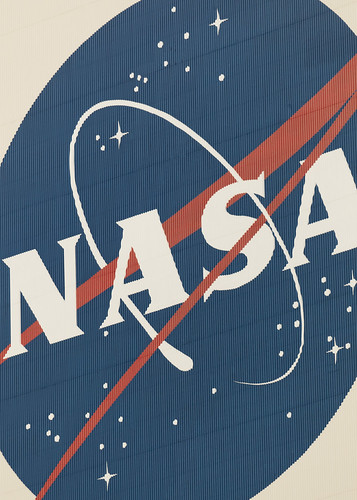
Launch is Go
As we passed the T-9 minute hold and the clock started counting down for what we hoped was the last time, we rushed to our positions. In our haste, we didn’t realize that the nice video and audio feed didn’t reach our positions, so the nice Camera Man next to us yelled out the count.
You might have heard there was a last-minute hold at T-31 seconds when the “Beanie Cap” (the gaseous oxygen vent arm) did not show it was latched down. As we were shut off from our source of information, and both the wifi and mobile networks were past saturation point, spectators plead to poor Camera Man, “Tell us what’s going on!” Camera Man reported back, “There is a hold of some sort.”
Then a cheer went up across the 3,000 strong spectators in the press viewing area, and the beleaguered Camera Man yelled you, “They restarted the count.” Camera Man gave us the count at T-20 seconds and we counted down with him.
At T-6 seconds the main engines ignite, sending steam high into the air. At T-0 the solid rocket boosters ignited, and Atlantis began her second, last flight.
This is joy; joy of hearing a safe throttle back to relieve the astronauts of the massive gravity force; joy of hearing the throttle up command but knowing that in 1986 six astronauts and one teacher lost their lives at about this point; joy in hearing the CAPCOM call out in successive moments abort locations, knowing that the violent thrust behind the astronauts both increase altitude, and brings them into a safer orbit; joy that eight minutes and thirty seconds later the call, Press to MECO,
is confirmed and the main engines cut off for the last time and the astronauts are in a safe, stable orbit.
The joy of seeing others around you laugh.
Cry.
And hug each other.
The happy aftermath
The launch of a Space Shuttle brings people throughout the world together to cheer four astronaut heroes, and to celebrate the labor of countless individuals and teams throughout the country. It is as if we find ourselves at a sporting event, and we are unified in cheering for the same team.
Inspiration was thrown around constantly over the course of the Tweetup. How we take that inspiration into action is something we should all contemplate.
While the Space Shuttle program enters her last chapter, the age of inspiration is not over. It certainly is not over at NASA, where it is clear that the ernest dedication of countless professionals will live on in current and future missions.
As the traffic was pilling up on the access roads north, west, and south, we chose to stay in the tent. Sharing photos and videos; a euphoria gripped the tent. Is this what obsessive feel like after they get what they want?
The minutes spread into hours, and a sort of open-mic night formed where people came up to the podium and shared stories. Asked to meet people they did not run into. All thanked Stephanie Schierholz, John Yembrick, Beth Beck and all of the NASA team for putting together the best-run Tweetup I had ever attended. The level of professionalism of all KSC staff – both civil and contract – was unparalleled.
Parting the crowd
It is currently Flight Day 9 of STS-135 Shuttle Atlantis – almost two-thirds of the mission is over. Most of the NASAtweetup members are home. Some departed right after the launch, some the next day, some stayed for the Endless BBQ and some went to Disney.
I get to go back to an awesome job, but I’m from a land in which earnestness is dismissed and irony is a currency. Yet, for a few days, there were over 150 people who were brought together to celebrate a program and its people; who celebrated astronauts and scientists like rock stars; who were not afraid to cry in public. That is something right there; something which we should continue to support; something we should nurture.
I want to thank all those who helped make three days amazing: friends from the VABhouse, all the NASAtweetup attendees, the Tweetup sponsors., and the many people at NASA who continue to innovate and inspire.
After the launch, I said (rather crudely): “America does cool shit.”
And we do.
Let’s keep doing cool shit; let’s stay hungry; and let’s continue to look to the stars, wherever those may be.
Godspeed Atlantis.
